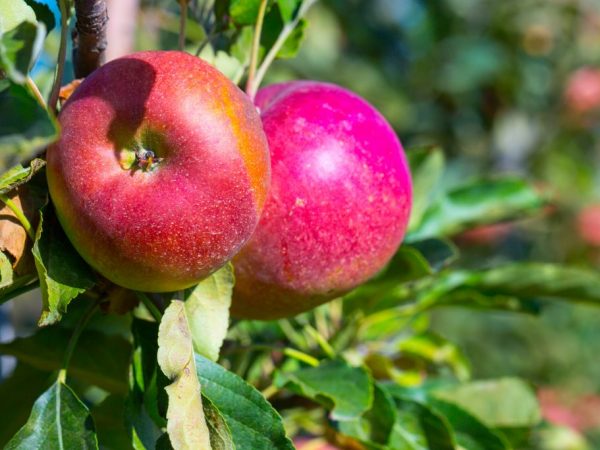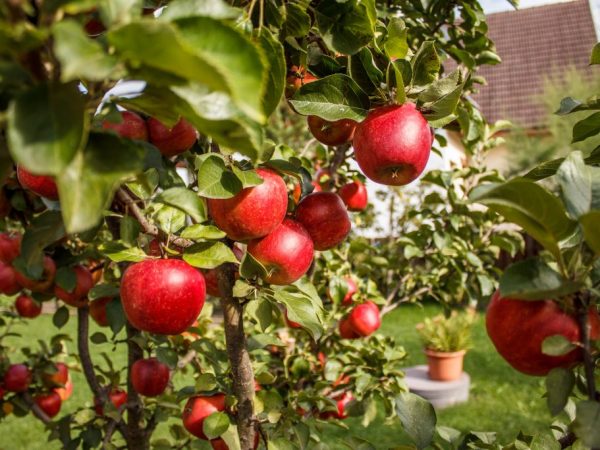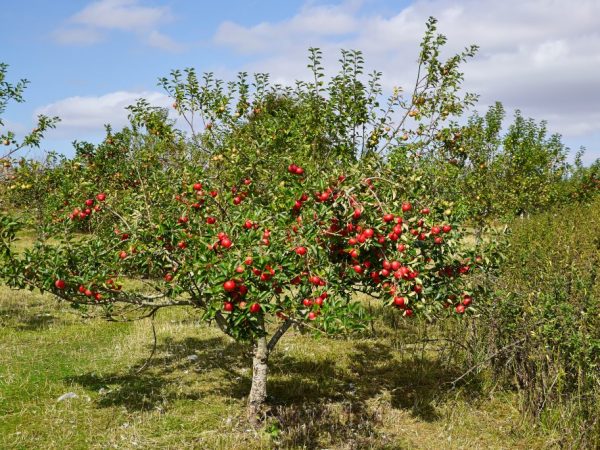Characteristics of the Imant apple variety
Apple-tree Imant is a Belarusian variety. It was given for testing in 1999. This culture is of a late ripening period; G. Kovalenko and D. Grakovich were engaged in its breeding. Since then, the species has shown its fertility in temperate climates and has gained popularity among gardeners.
- Description
- The appearance of the tree and fruit
- Yield
- Winter hardiness
- Disease immunity
- Tree lifespan
- Suitable climate and regions
- Advantages and disadvantages
- Landing technology
- Sapling selection
- Site preparation
- Landing scheme
- Care
- Watering
- Top dressing
- Pruning
- Prevention of diseases and pests
- Preparation for wintering
- Harvesting and storage
- Gardeners reviews

Characteristics of the Imant apple variety
Description
This is a relatively new species and is still being developed on the farm. Before buying a variety, you need to know its distinctive characteristics from other species and hybrids.
The appearance of the tree and fruit
The tree is of medium vigor, rarely more than 3 m in height. The crown is thick, but not slender.
It grows slowly, showing a large yield every year. Does not need crown formation. The first fruits appear on one- or two-year-old plants.
Apples are above average in weight - about 180-200 g. Round with a blunt end, ribs are clearly visible. Color description:
- the main one is green;
- almost the entire skin is covered with a purple color, sometimes with a purple tint;
- the pulp is light green.
From a distance, the fruits appear more purple than pink. The pulp is sweet and sour and fine-grained. Assessment of tasters - 4.2 points. The chemical composition is distributed as follows:
- Dry matter accounts for 12%;
- 11% sugar;
- titrated acids - 0.6%.
Vitamin C - 8.7 mg per 100 g. Because of this indicator, the pulp has a specific sour taste. Lying and ripe fruits are considered the most delicious. The consumer season starts in January - February. Imant apples lie well at a humidity of 60% and a temperature of 0 ° C until the end of April.
Yield
High-yielding species. An apple tree more than 5 years old grows 25 kg of fruit if conditions are favorable. Begins to produce fruit from 2-3 years of age.
Winter hardiness
Relatively high, the variety can withstand up to -25 ° C at normal humidity. The selection took into account the need for fruit in temperate regions, so the cultivar was grafted with a gene for frost resistance. It winters well with proper preparation, tolerates spring drops even with blossoming buds.
Disease immunity
The imant was bred to be scab resistant. Almost does not suffer from bacterial cancer, cracking of the bark, is not susceptible to gum flow. Fungi and bacteria are serious tree diseases. On unsuitable soils, apple trees are affected by other pests.
Tree lifespan
Like other apple trees - about 15-20 years old with proper care. The variety does not differ in durability, after 10-15 years the yield decreases. It is important to harvest the fruit on time so that the branches do not break off under their own weight.
Suitable climate and regions
Due to its high winter hardiness, the variety is grown in a temperate zone; a climate with hot summers and cool winters suits it. The region is European. In the Urals, Siberia or the Far East, the species does not take root, the northern winters are too cold and dry.
Advantages and disadvantages

The fruit tastes good.
Pros of the variety:
- scab resistance;
- high productivity;
- winter hardiness;
- early maturity;
- compactness of the crown;
- the taste of the fruit.
The dark color of the fruit is considered a significant drawback, although many gardeners choose the variety for this very reason. Also Imant is not suitable for northern regions, which reduces the area of cultivation.
Landing technology
When preparing a site for planting, you need to take into account the number and density of the crown of crops, as well as think over the care and harvesting. For quality products, they buy certified seedlings, because otherwise there is a risk of acquiring a fake. Real Imant apple trees are unpretentious and require minimal maintenance.
Sapling selection
Purchase them in agricultural shops or nurseries. You can choose trees grown north of the region: they precisely adapt to the milder climate.
Characteristics of a good seedling:
- age 1-2 years;
- thin twig without side shoots;
- the roots are smooth, without fungus and peeling;
- the wood underneath is light green;
- the living root is white when peeled off with a fingernail.
Saplings with leaves are not bought.
Site preparation
This procedure takes place in advance, 14-20 days before planting the seedling. Pits are prepared with a diameter of 80 cm and a depth of 70-80 cm. Then they are filled with peat, compost, humus, sand. Various fertilizers are added.
Everyone falls asleep sequentially, alternating layers and throwing a handful of additives into each. Then mix with a shovel. You need to fill the hole with a slide. Otherwise, after 5 years, the tree will sag and will not produce a high-quality harvest.
Now a hole is being prepared for the roots of the seedling. Some are sold with a closed system, already in a cube of land. A hole is made in the prepared hole, a tree is installed and covered tightly. After tamping, pour a bucket of water over it.
To fix the young tree, set 3 stakes in a triangle. Their height is about 30 cm above the ground and 50 cm below. The sapling is fixed between them with ropes.
Landing scheme

The tree needs a lot of space
In southern latitudes, they practice landing before winter - at least 2 months in advance. before frost. In temperate climates, it is better to choose spring. Before flowering, the seedling will have time to take root and be saturated with juices in order to bloom. Because the Imant apple tree is not too tall and spreading tree, then the planting scheme is as follows:
- 3-3.5 m between seedlings;
- 4-4.5 m between rows.
If varieties of different strength of growth are planted in a row, then the distance is corrected. Otherwise, a spreading tree will shade a small one, the yield will decrease.
Care
The variety is unpretentious, but in order to obtain the maximum yield, the tree needs to be well looked after.
Watering
If there is no rain and the weather is hot, then water the tree once a month. It is better to give the liquid not at the root, but in the furrows nearby. In extreme heat, watering is increased: 1 time in 15 days.
Be sure to give liquid during these periods:
- during the opening of the buds in the spring;
- 20 days after flowering;
- 30 days before picking apples.
If watered later, the fruits are saturated with moisture and have an unexpressed taste. Water consumption for 3 irrigations - 60-70 liters.
Top dressing
Starts from the second year. Prior to this, the tree feeds on fertilizers from the planting pit. Nitrogen-containing substances are introduced, rotted manure. The latter is given only in the spring, then it will interfere with the fruit setting and enhance the growing season.
During flowering, phosphorus and potassium are needed. These same substances are fed in the fall before wintering.
Pruning
Apple trees of the Imant variety do not require crown formation, so pruning is preventive. It is made in the spring after the thaw and in the fall. During pruning, remove:
- lateral processes, making the crown symmetrical;
- branches that have gone to the side, loaded with fruits;
- dry, rotten, broken shoots;
- wood with signs of mold and pests.
It is also recommended to remove the lower branches and those that are directed inward. They only load the tree and bear little fruit.The optimal shape of the crown is sparse-tiered, each level consists of 4-5 skeletal shoots and the same number of branches of the first and second order. Plant residues are burned.
Prevention of diseases and pests

Processing will protect the tree from pests
Spraying with a 1% solution of copper sulfate is used as an economical and effective means. It is diluted in a ratio of 100 g per 10 l of water, the trunk and leaves are covered with it several times a year:
- in spring after thaw to bud set;
- after swelling of the kidneys;
- 1 time in summer before fruiting;
- 1 time before wintering.
Such processing allows you to protect the tree from weevils (flower beetles), moniliosis, rot, fungi. The Imant often eats the leafworm. They fight against it with insecticides, remove the infected plates (they curl into a tube).
Mandatory preventive measures include:
- cleaning the trunk circle from organic residues. In spring and autumn, fallen leaves, old dry branches are raked up and burned;
- inactive shoots are cut from the tree. Dry branches too, they can contain pests;
- cleansing the trunk from keratinized bark. Lime treatment;
- breaks and cuts are covered with garden pitch;
- use sterile instruments to form the crown.
Sharp-smelling flowers and cultures are useful against insects: flower beetles do not like nasturtium, marigolds; planted next to garlic, onions, wormwood, spices.
Preparation for wintering
It consists in removing the leaves from the trunk. Young and adult seedlings are cleaned of bark, whitewashed. Two- and three-year-old apple trees are recommended to be prepared for winter as follows:
- the trunk circle is covered with a 10 cm layer of peat or humus;
- a hill is made at the base;
- the trunk is wrapped in burlap, nylon, air-permeable cloth;
- after the snow falls, a 50 cm snowdrift is made.
In southern climates, such training is not necessary. Closer to the north, the number of layers of covering material increases. Dry and frosty winters without snow are unfavorable for the apple tree.
Harvesting and storage
The fruits ripen in late September - early October. Fruit can be picked up from the ground, but damaged fruit is immediately processed. In ripe apples, the stalk comes off easily, dents remain on the skin after pressing. The seeds are uniformly brown, and there are fallen fruits on the ground without damage from insects.
The Imant apple variety is stored in several ways:
- in a cellar or storage. Slightly unripe fruits are selected, put in boxes and interspersed with straw. So the variety will last until April - May;
- at room temperature lie for about 2 weeks, ripening. Fully ripe fruits spoil after 7 days;
- stored in the refrigerator for up to a year. They successfully transfer freezing in the form of blanks.
Gardeners reviews
They note the resistance of the apple tree to frost and high fertility. Fruits do not fall off, they stay on the branch for a long time even when ripe. The taste reveals closer to November after storage. Some have noticed that the pulp is dense, sometimes too sour if the tree has received less moisture.
Gardeners from the north tested the Imant: some of the trees have taken root, but they give an abundant harvest. Therefore, it is recommended to plant it in temperate latitudes, not forgetting to protect it for the winter. Even 1-year-old trees take root well when planted in spring.


